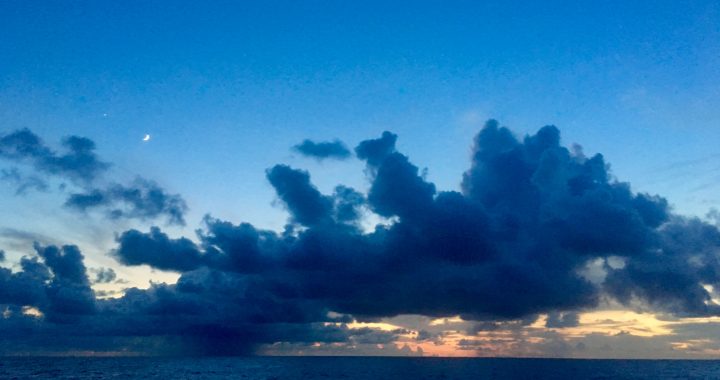
Caption: All smiles, blue skies and great sailing from Bermuda to the Azores.
One of the best feelings at sea is the slowly building warmth of the morning sun. It just feels good. It is also the time I check my IridiumGo! for new messages and get a weather update. I am only a few days from completing my solo Atlantic passage and it has been a fantastic adventure.
MORNING WEATHER MESSAGE FROM PETE – July 21, 2018
“Hi Rod,
Sounds like you are enjoying yourself even with the light winds. While things are quiet, pass a few scenarios of “what if”. Do you still have a fouled prop? Checking props before turning? How about strong wind reefing, i.e. when/how do you do it? Best course in a big sea so that the downwind hull is less likely to dig in? You know more about big cats in heavy weather.
Don’t get worried as there is nothing to worry about now (in the weather), but I am really thinking about the next leg, maybe? You have had it easy so far.” Pete.
In the age of satellites and the internet, a solo passage is not what it was just a few years ago. The reality is that you are really only solo “physically,” you can have almost instant guidance and communication at any time… worldwide. So, you are not necessarily, “alone”. I had met Pete 3 years before in Simpson Bay, St. Martin and became friends over several subsequent meetings and shared problem solving sessions after which we had kept in touch. Pete has a lot of knowledge and firsthand experience in making solo Trans-Atlantic passages (five to date). I was very fortunate he was willing to share that experience freely and know he was “watching my back”.
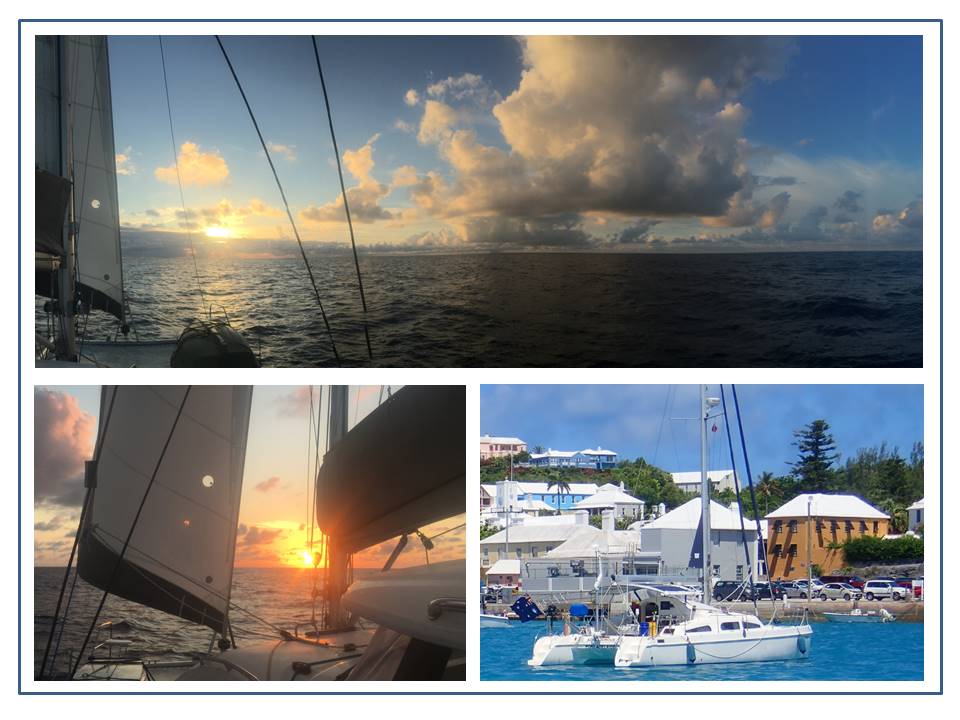
Caption: Clockwise, Another beautiful sunrise with a squall line ahead. David and Mary’s Prout 38 foot Catamaran in St. Georges harbour where we met. The warm glow of the sun as it rises to greet another day at sea.
My solo passage wasn’t planned as such…it evolved. Delays, deadlines, timing and personal circumstances all combined to find me anchored in St. George Harbour, Bermuda, July 6th contemplating a solo voyage, but where? Sailing back to the Eastern USA and putting Oh! in a boat yard for the summer seemed most likely; or across the Atlantic to explore the Azores? Those were my only options and each was a solo passage.
As with most big decisions in life they are rarely simple and there were a lot of stressful forces swirling around me as I contemplated what to do – the least of which was Hurricane Chris that was making its way north toward either Bermuda or the eastern USA. What Hurricane Chris’ ultimate path would be was still to be determined. Pete knew about all those pressures and stressors and initially advised me not to go. Then he offered how his first solo came about and what he learned from it. In a message July 6 while I was still in Bermuda contemplating where to take OH!, Pete wrote;
“If you don’t mind me saying, you have got yourself into a difficult situation with so many external pressures just prior to sailing the Atlantic solo where you need the clearest of mind to prepare yourself and your boat.”
He also noted the need to get Oh! out of Bermuda as the Atlantic storm season was already under way. The need to find a suitable place to go with Oh! was mounting. He ended his message that day with a comment that would change everything.
“I had something similar at the start of my first passage back (from the Caribbean to England). My crew bailed out at the last minute but I decided to go solo having never sailed solo before. It was the best decision as I enjoyed the independence to have my own routine (music on loud, meals at odd times, snooze when convenient) without the responsibility of the safety of others. As Skipper you know what has to be done, but you have to do it (alone). If you apply conservative sailing and good weather information you will be ready for most situations. Check every shackle, split pin, rope, nut and bolt, especially up the mast…” Pete.
Pete’s message really hit home. I knew I could do the solo passage…the questions was, to where? Later that day as I was heading back to Oh! I spotted the couple working on the Aussie catamaran anchored next to Oh! and went over to say, “Hi, did you sail that boat all the way from Australia?” As detailed in my first article, “It all starts with Hi…”, that visit was all I needed to convince me I wasn’t returning to the USA to put Oh! away for the summer, or even worse, sell her. Mary, David and I quickly connected and that visit plus an impromptu dinner with them that evening on Oh! reminded me why I love the cruising lifestyle. It’s the people I get to meet and spend time with. After sharing IridiumGo contact information and email addresses, we agreed to stay in touch as we sailed to the Azores. Also, just so it wouldn’t be a race, they would get a 4 day head start while I waited for a new heat exchanger hot water tank to arrive. It was July 6th and a beautiful warm clear night in Bermuda. I was now fully committed to going solo!
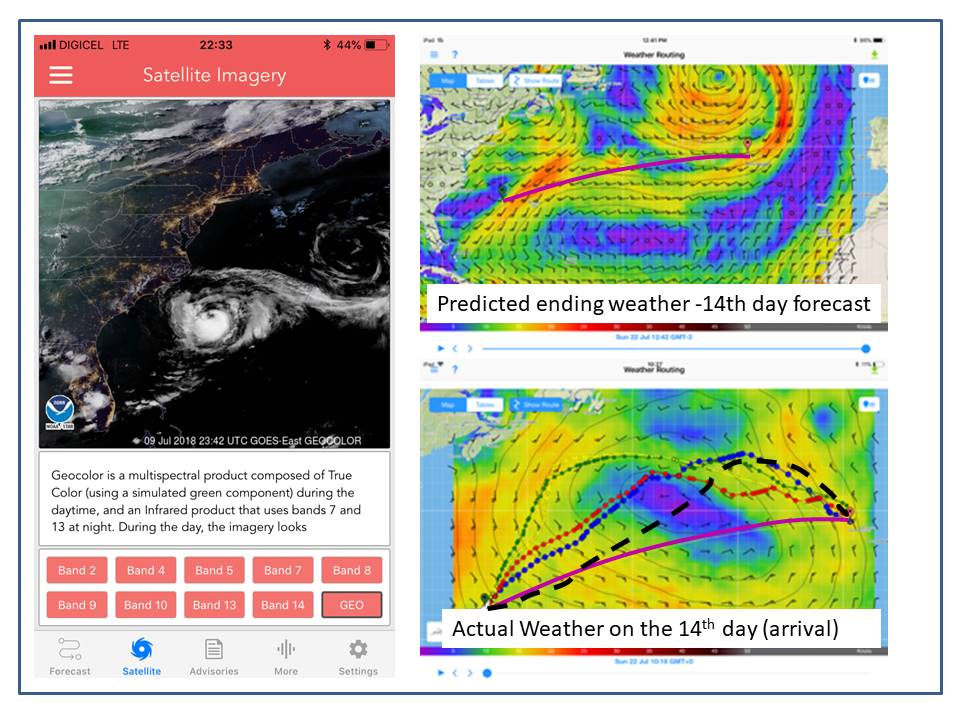
Caption: Hurricane Chris on July 9th between the USA and Bermuda. The last day of a 14th day weather prediction, and what really happened on the 14th day out. Note how the predicted high had moved considerably north. The Rhomb line is in Pink and my actual track in black dashes.
The classic route to the Azores from Bermuda is to sail northeast to about 41 degrees north then east around the northern edge of the Azores High Pressure system that develops west of the Azores archipelago, then turn south toward the Azores. Typically you need to motor the last day or two into the no wind high pressure zone to make landfall in the islands. Simple enough, with twice daily weather charts from my Predict Wind Offshore and Pete’s daily independent analysis from England, it should be a simple exercise of staying close enough to the high pressure area to be in 10-15 knot winds and enjoy a beam to broad reach sail the entire voyage. The side benefit is the high pressure system would likely mean sunny days! Plus the calm high pressure area might potentially be a place to run to if a low pressure with high winds and bad weather started moving south out of the North Atlantic.
To make a long story short, the voyage was perfect. That seems to be the best way to describe it. The weather was excellent and although the initial 14 day forecast suggested a simple Rhomb line route, as the plot shows, the high moved north and my route followed an almost classic route sailing north around the Azores High as it migrated northwest.. I only experienced two large sets of squall lines to navigate around and the rest of the time it was warm sunny days and star lit nights. At no time was even a light windbreaker, or any warm clothing needed. Not even at night …and wow, the night skies were incredible! On moonless nights, or after the moon set, I could clearly see areas of different star density within the Milky Way. It was just like the images I would see when pointing my iPad Stargazer app at the night sky. Also, at night the navigation lights on Oh! attracted the sea birds, especially the white stern light. It was fun to watch them swoop and dive around the stern in and out of the light.
As I got closer to the Azores, encounters with pods of dolphins become more frequent, and multiple whale spouts were seen, including 2 huge breaches as the whales leapt out of the sea. Along the fringes of the Azores high, the winds are much lighter and the seas are calmer so dolphin and whale sightings are more frequent simply because they stand out better in the flat to gently rippled seas. Unfortunately, so does the amount of plastic floating in the ocean! Mostly drinking and cleaning bottles, but they were almost constantly within eyesight and very visible in the calm seas. That was a real surprise and wake up call to the amount of plastic out there.
The goal for Oh! however, was to sail around the high pressure area in the light S-SW winds. I am proud to say I literally sailed the entire distance from Bermuda to within 20 hours of making landfall. The engines were used only 6 times. Twice to charge batteries while in neutral (using the starboard engine with the snarled prop), and four times to briefly hold Oh! into the wind while I had to raise, lower, or change the reefing on the mainsail. For that I used the port engine with the functioning prop. To sail almost the entire route without any amount of significant motoring was a fantastic feeling.
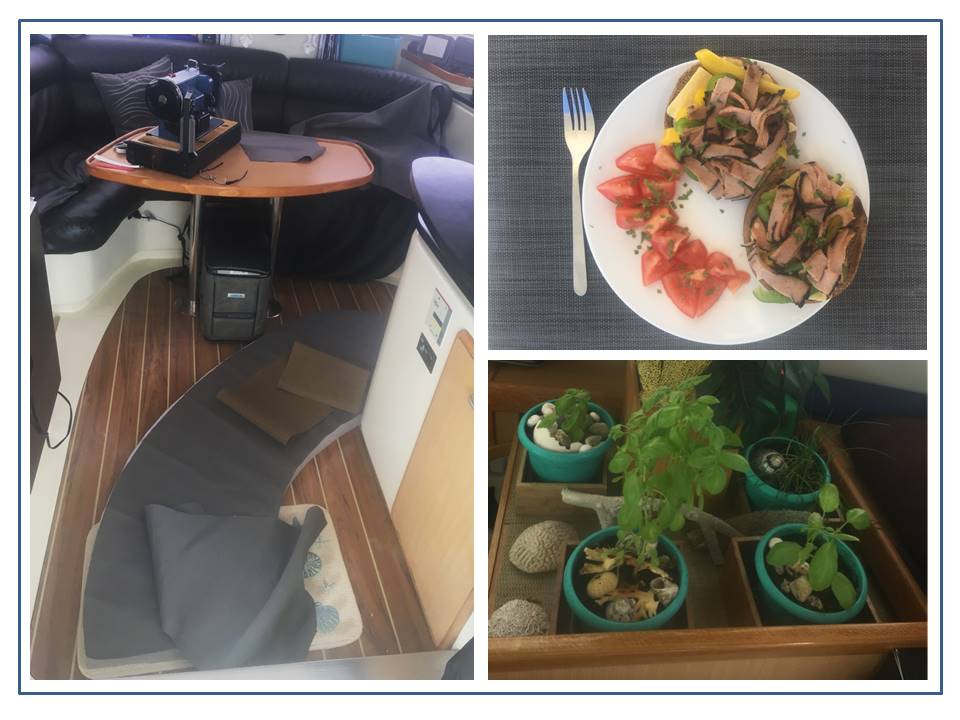
Caption: Making a new cockpit cushion cover. A typical lunch of broiled ham and cheese with bell peppers on a bagel, accompanied by tomatos and fresh basil. Oh!’s garden of culinary delight.
Some may wonder, wasn’t it boring? The answer is an emphatic “not in the least”. There is always either something stunning to see, routine chores to do, or sleep to catch up on. I had more to keep me interested and occupied, than I could possibly get done each day. Plus, when you need to nap every few hours, time goes by very fast. The days were filled with yoga on the tramp and foredeck in the morning sun, making new cockpit cushion covers and canvas work for the Bimini, repairs to the heat exchanger lines, baking, cooking and analyzing weather.
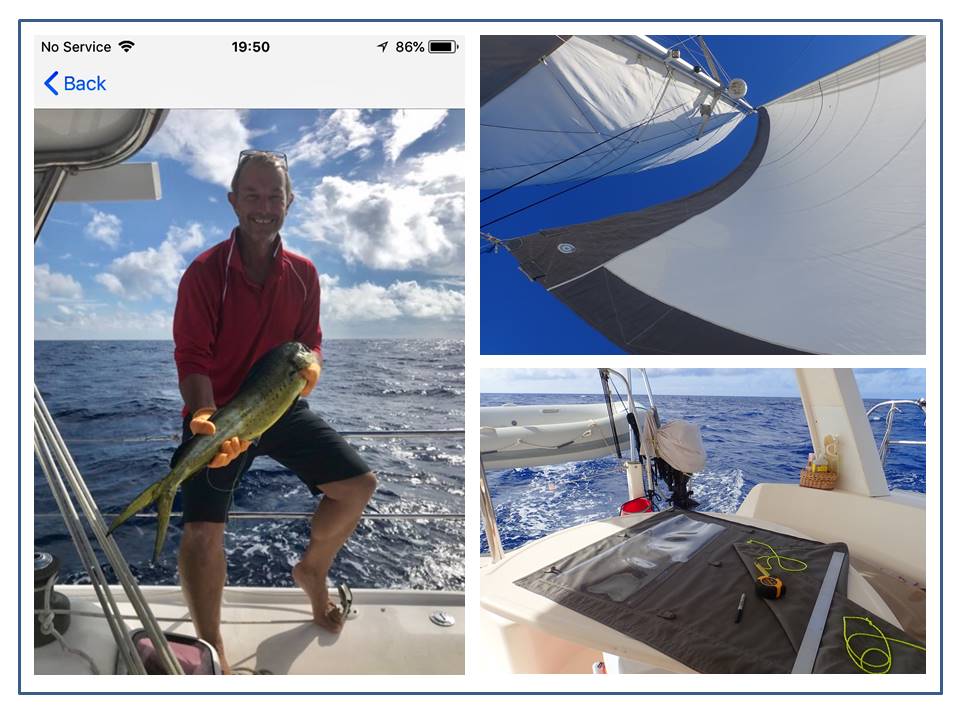
Caption: Picture sent over IridiumGo! of David all smiles with a fresh Mahi for dinner! The “Art of Sailing”, looking up during a relaxing coffee break on the trampoline, look at the color of that sky! A new cockpit canvas for the helm station gets completed.
Plus the frequent flow of text messages between David, Mary and myself kept the voyage interesting as we ended up in a light hearted AUSSIE RULES (meaning no rules) Trans-Atlantic race. He even claimed the rope that fouled Oh!’s starboard sail drive was thrown overboard by him to slow me down as I quickly caught up to them despite their 4 day head start. I guess all is fair in Aussie Rules! After a good laugh about his comment it became a great source of chatter as we made the passage and yes, he got his rope back when I arrived in Flores! However, they ran out of eggs…and were very jealous of my stock of eggs for breakfasts and baking. So… I may have lost the race, but I got to enjoy eggs for breakfast longer!
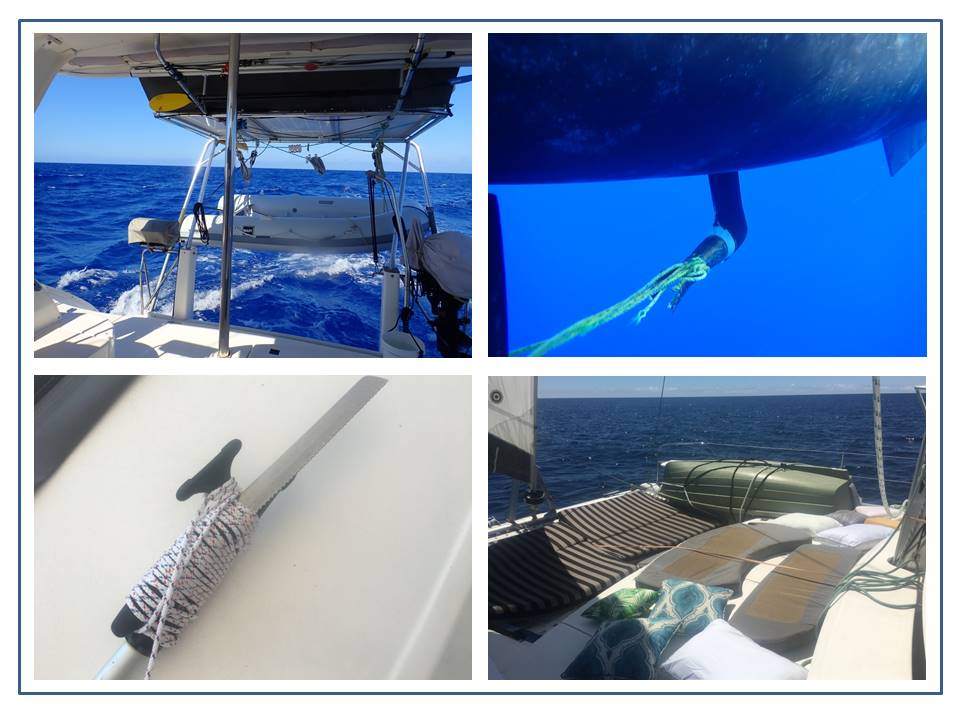
Caption: A typical day on the voyage. The rope somehow lassoed one blade on the starboard prop and I could not free it without going overboard which I wasn’t about to do. A makeshift long handle knife using the boat hook could not reach the rope either. Airing out the pillows and mattresses on a calm day in the mid-Atlantic while sailing at 6 knots!
I have a fascination with clouds. Partly from my enjoyment of soaring where I need to “read the clouds” to find lift, but also from the physical science side. What causes that type of cloud to form there, while a totally different cloud type is forming in another direction? Or, for a more directly applicable reason; to determine if there is a pattern to where the massive cumulous and cumulonimbus clouds will finally collapse in a fury of downdrafts and rain. Cloud gazing on the open sea fascinates me. I know – I am a bit strange, but anyone who knows me and hasn’t observed that by now, probably hasn’t been paying attention!

Caption: Sunset with a massive squall on the horizon. No green flash, but the sunsets were incredible each evening. A Radar plot showing a squall line and the actual squalls to the left.
Would I ever do a long solo passage again? Without hesitation, the answer is a resounding, yes! Now I fully understand what drives people to do solo voyages. It is so liberating and stress free. My daily routine was dictated only by the weather, myself, and the decisions I make. With only a few exceptions, there were essentially no other external pressures, or inputs to deal with. No traffic, no crowds, no meetings, no personalities and no conflicts. The challenges were;
- A) Working with the forces of nature, and
- B) Dealing with routine or unpredictable mechanical issues while solo. Surprisingly, even those unpredictable issues were not stressful – they just become another item on the boat “to do list”, which is a constantly changing and growing list of priorities and wishes. On the Trans-Atlantic voyage the mechanical issues were;
- The snared starboard sail drive which limited that engine to being a generator…probably courtesy of a couple of Aussie’s. Race committee, I would like to file a protest! Oh yah, Aussie Rules means no committee and no rules.
- Persistent leaking coolant lines to the new port hot water heat exchanger, a rather straight forward fix, but it was a tedious job due to poor design of the heat exchanger.
- Bilge pump lines that were installed without anti-syphon loops that trickle water into the bilges whenever waves slapped under the bridge deck. That meant some minor regular bailing every few days and my head upside down in the bilge. Thankfully it was very calm and the amounts were only a bucket of clean sea water.
- A broken mainsail outhaul line, due to chaffing on a worn pulley. Again an easy fix that now has a nice Kevlar anti chafe sleeve,
- Two pop rivets that broke around the gooseneck on the boom. These were due to internal corrosion and simply appear to be failing with age. They all got replaced in Horta, by Mid-Atlantic Yacht Services (MAYS).
- A T-hook on the port inner shroud failed in light winds and seas just 20 hours from the island of Flores. Again Mid-Atlantic Yacht Services were great and had everything in stock to fix the issue. Great service and very knowledgeable owner.
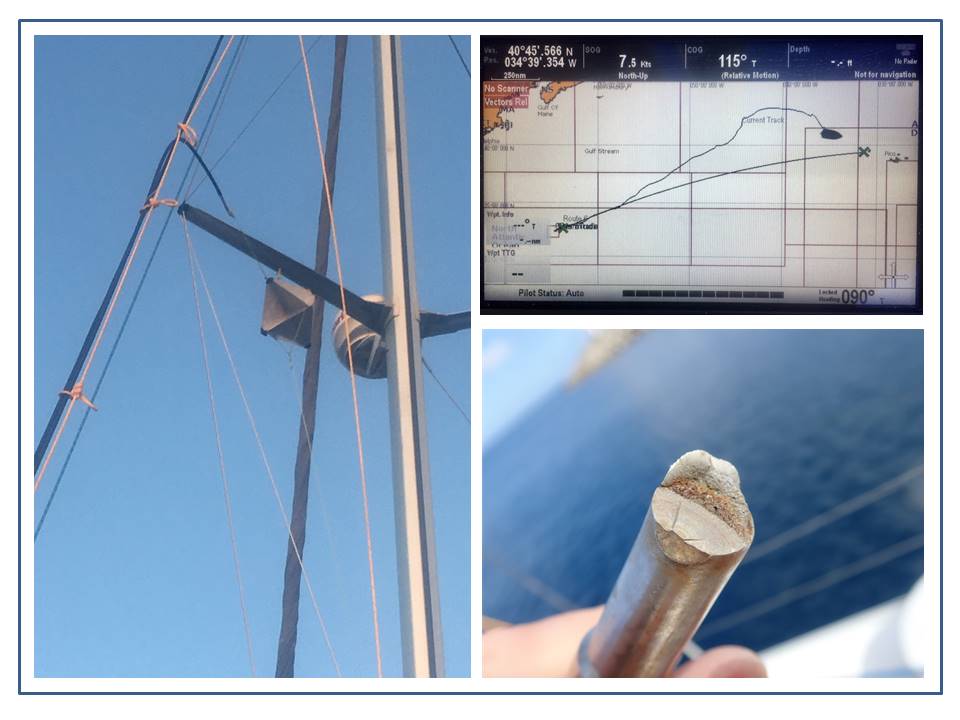
Caption: The series of bowlines hoisted by the main halyard to stabilize the broken inner shroud to the cap shroud. Almost there, just 20 hours out when the shroud broke. The Navtec T-Hook that failed.
All pretty minor stuff, with nothing threatening to my safety, or the seaworthiness and integrity of Oh! that could not be dealt with other than the shroud failure. The standing rigging had all been replaced just four months earlier, so to have a T-hook on a shroud fail in only 12-15 knot winds and a gentle 0.5 -1 m swell was a surprise. It also highlighted the value of mast steps when you are sailing solo. Oh! does not have steps, so the broken shroud was an issue that could not be easily jury rigged. Also, the shroud was held aloft by a 2 mm line that was used to secure the radar reflector in place just below the port spreader. If those lines failed, the cable and heavy T-hook would come crashing down to the deck with the risk of breaking a hatch or window; or worse going overboard where it would almost certainly foul in the port prop which was my only functioning engine. Since I could not go up to secure or remove the shroud, the best solution seemed to be to secure it to the top shroud. The main Halyard was used to hoist a set of small bowlines every 1-2 meters that held the broken inner shroud to the top shroud. That took the pressure off the thin 2 mm lines securing the radar reflector, plus eliminated the risk of the shroud going overboard as I motored the last 20 hours into the western most Azores Island of Flores. It was a bit of a disappointing ending to such a great passage for two reasons;
- With the fresh NW wind on day 13 of the passage, I came within 100 miles of sailing the entire passage.
- I had to finally concede to the Aussies since with the fresh winds they could now do 6-7 knots and I could only do 5-6 with only the port engine as I wasn’t about to raise any sails… but then it wasn’t a race – right? (Where is the race committee when you need them?)
Working with the forces of nature was the most intellectually challenging, interesting and rewarding part of the voyage. The day to day analysis of forecasts and working with the dynamics of constantly changing weather and seas has been interesting and rewarding – especially since I had no deadlines – none. So… if I wanted to change course to take a route closer to the center of the Azores high to get calm seas and gentle sailing, but would be slower – I could. That luxury of having almost no “time restrictions” is truly liberating. A friend who motorcycled around the world once told me the most valuable currency he could have was “time”. I could not agree more! I can make water; have plenty of fuel, and enough food for months. The only real forces driving decisions were;
- Personal enjoyment of the voyage and,
- Safe routing to avoid as best I could any forecast rapid change in the weather to a system that might be threatening, or dangerous.
Along the way I have had plenty of time to work on Oh!, note areas that need attention and consider some “what if scenarios” and the resources I had to deal with them. It was a great working classroom for preparing Oh! for future voyages. Plus, experiencing the many rewards of a long solo passage was something that was very special.
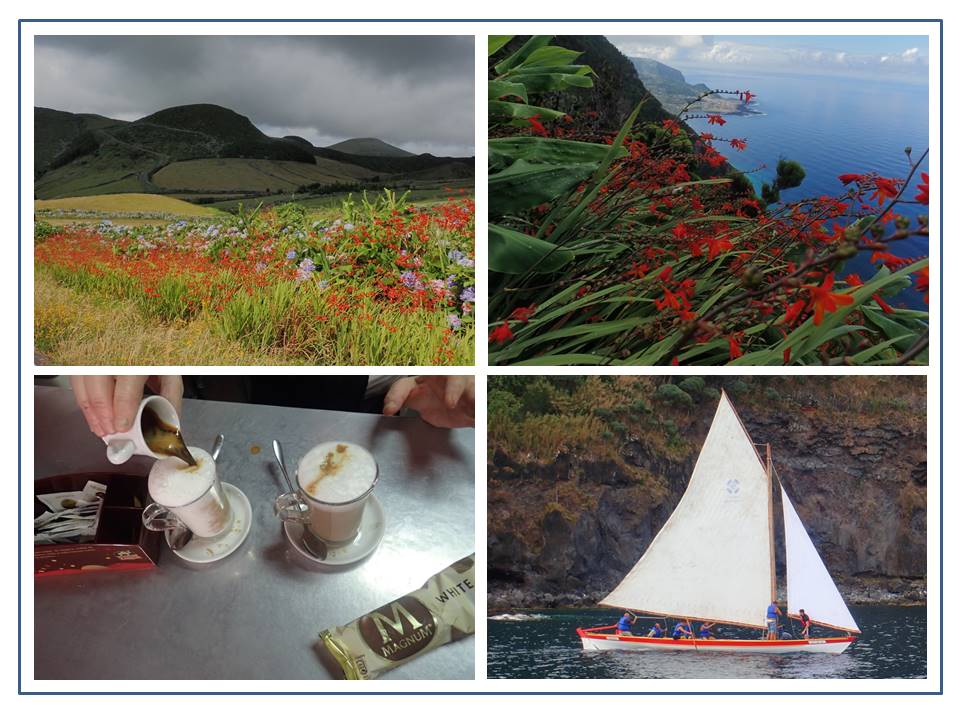
Caption: Flores is aptly named. It is laced with beautiful flower covered stone walls, dramatic topography, incredible cliffs, hiking trails and seaside natural swimming areas. The residents are proud of their whaling history and keep it alive through museums and an interest in sailing the traditional whaling boats. The Galoa’s (latte’s) are both excellent and inexpensive enough to reward oneself with a treat or two!
The voyage went so well, I really did not want it to end. However, a new adventure was waiting at the Island of Flores. The passage was 1860 nmi. and took 13 days and 20 hours to complete. The last 12 hours were spent drifting quietly down the east side of Flores waiting for sunrise before going into the small anchorage and harbour at Lajes on the southern tip of the island. Once I was hooked I immediately slipped overboard to untie my starboard prop and then returned David’s rope!
Cheers from Oh!
